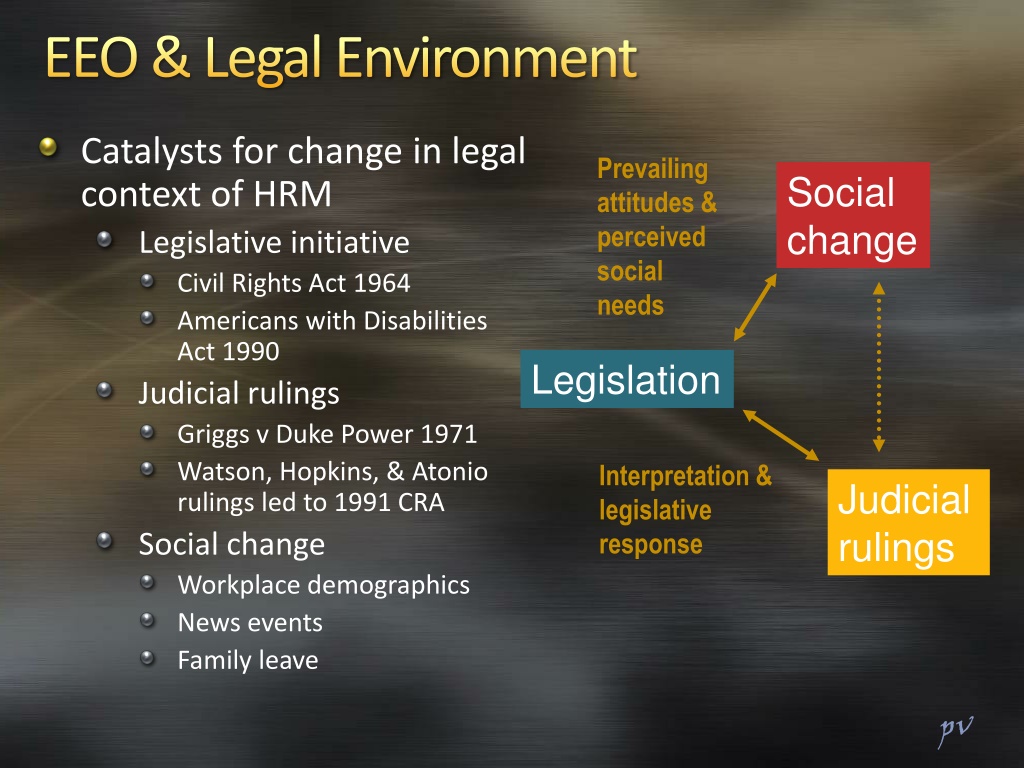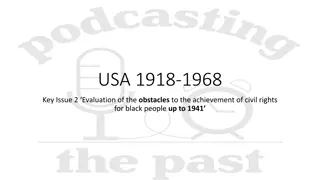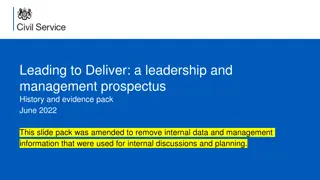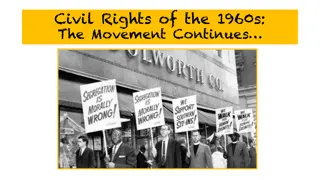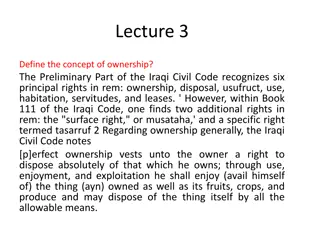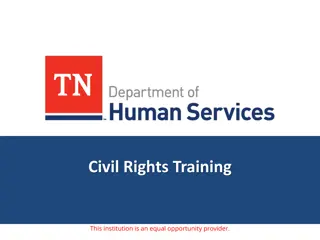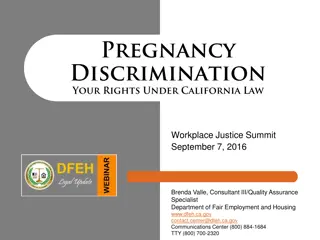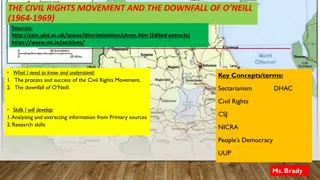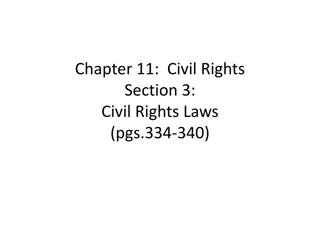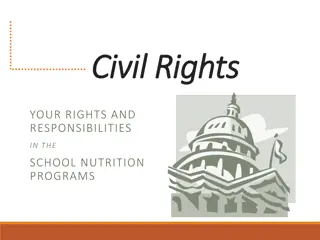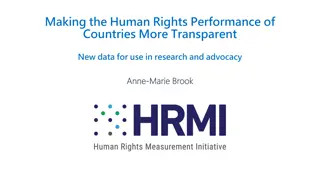Evolution of Civil Rights Protections in the Workplace
Explore the journey of civil rights protections in the workplace, spanning from the enactment of the Civil Rights Act of 1964 to the Equal Pay Act of 1963 and beyond. Discover key legislative initiatives, judicial rulings, social changes, and prevailing attitudes that have shaped the legal environment of HRM. Uncover insights into gender pay disparities, Equal Employment Opportunity Commission (EEOC) enforcement, and the impact of educational choices on the pay gap.
Uploaded on Oct 10, 2024 | 0 Views
Download Presentation

Please find below an Image/Link to download the presentation.
The content on the website is provided AS IS for your information and personal use only. It may not be sold, licensed, or shared on other websites without obtaining consent from the author. Download presentation by click this link. If you encounter any issues during the download, it is possible that the publisher has removed the file from their server.
E N D
Presentation Transcript
EEO & Legal Environment Catalysts for change in legal context of HRM Legislative initiative Civil Rights Act 1964 Americans with Disabilities Act 1990 Judicial rulings Griggs v Duke Power 1971 Watson, Hopkins, & Atonio rulings led to 1991 CRA Social change Workplace demographics News events Family leave Prevailing attitudes & perceived social needs Social change Legislation Interpretation & legislative response Judicial rulings pv
A Brief Chronology of Benchmark Civil Rights Protections in the Workplace since 1960 1963: Equal Pay Act Prohibited sex discrimination in pay 4 compensable factors scheme Skill, effort, responsibility, working conditions Pay for similarly classified job allowed to differ because of: Seniority, performance, piece-rate, schedule effects Women earn approximately 80 cents per dollar of male pay (full-time, year-round) when aggregated across all jobs When limited to the same job the difference amounts to 7 cents on the dollar Differences in seniority and assignments (e.g., travel) as well as potential discrimination or absence of advocacy have been cited as primary causes pv http://www.eeoc.gov/laws/statutes/epa.cfm http://www.eeoc.gov/laws/statutes/epa.cfm
Graduating to a pay gap College education actually increases the pay gap Larger differences in pay among better-paying jobs Greater pay-parity among lower paying jobs Choice of major and industry employment Humanities, social sciences, education Among social science majors men work in different jobs (management 26% vs 11%) versus (social service 16% vs 9%) The pay gap grows over careers From near parity at graduation to 93.4% at one year post graduation Discrimination is but one factor among many http://www.aauw.org/files/2013/02/graduating-to-a-pay-gap-the-earnings-of-women-and-men-one-year-after-college-graduation.pdf pv http://www.consad.com/content/reports/Gender%20Wage%20Gap%20Final%20Report.pdf
A Brief Chronology of Benchmark Civil Rights Protections in the Workplace 1964: Civil Rights Act Title VII is portion of 1964 CRA that details employment opportunity & condition guarantees Prohibits discrimination based on race, color, religious beliefs, sex, or national origin Any such discriminatory decision is labeled illegal discrimination; religious organizations exempted from religious provision Applies to all organizations employing 15+ workers employed 20+ weeks per year Establishes an enforcement agency called the Equal Employment Opportunity Commission EEOC 1960 s: Executive Orders (# 11246, notably) Regulate federal contractors and subcontractors (OFCCP) Provided for Affirmative Action Programs for non-compliance pv
A Brief Chronology of Benchmark Civil Rights Protections in the Workplace 1967: Age Discrimination in Employment Act Amended in 1986, prohibits discrimination against those 40 years of age or older Has effectively banished mandatory retirement ages 1978: Pregnancy Discrimination Act Regulates treatment resulting from pregnancy & fetal abortion; FMLA 1993 is similar Pregnancy treated as a medical disability for purposes of paid leave, service in the position, & restoration of employment conditions Benefits Survey @ BLS Novartis 2010 Discriminated in pay, promo, pregnancy (5,600 ee s implicated) $250 million punitive damages pv http://blogs.findlaw.com/decided/2010/05/250-million-plus-novartis-liable-in-sex-discrimination-suit.html
A Brief Chronology of Benchmark Civil Rights Protections in the Workplace 1990: Americans with Disabilities Act Prohibits discrimination based on physical or mental handicap Extended to increasing physical accessibility for disabled to new building construction Requires job analysis to detail critical functions and state requirements in job description (e.g., climbing ladders) Disability Includes wide spectrum of psychological disorders but not elective impairments or such pathologies as gambling, sexual behavior disorder, and pyromania. Reasonable accommodation Obligation of employers to accommodate employees with known disabilities unless this would produce undue hardship Allegedly often abused provision pv
A Brief Chronology of Benchmark Civil Rights Protections in the Workplace 1991: Civil Rights Act Prohibited race-norming & quotas Provided for punitive awards in instances of deliberate discrimination Established the use of jury trials in cases where punitive damages are sought Clarified culpability of mixed motive decisions If dual motives present, defendant is liable Plaintiffs must identify specific discriminatory practice (process of disaggregation) pv
Benchmark Prima FacieCases Disparate Treatment Illegal discrimination directed at one employee resulting from the application of a different process This is an isolated case instance that may be supported by aggregate data showing a pattern of discriminatory practice Disparate Impact Evidence of adverse impact is based on aggregate data showing that protected class members were subject to disproportionately negative outcomes despite use of the same process 4/5ths Rule Sometimes distinguished as intentional versus incidental discrimination. pv
McDonnell Douglas v. Green (1973) Origin of 3-phase evidentiary framework for DT cases prima facie Plaintiff burden productive defense Defense rebuttal Pretext Plaintiff burden Mixed motive cases Percy Green filed suit subsequent to being laid-off by MDD. While laid-off he participated in several illegal work stoppages ( stall-in ). pv Disparate Treatment Cases
Prima Facie Evidence for DT Cases McDonnell Douglas v. Green (1973) was a member of a relevant protected group applied for a position for which he was qualified was rejected despite qualifications the position remained open (or was given) to a person who was of equal or less qualified Green failed to demonstrate that MDD rehired white applicants, but not black workers, who also committed similar acts against the company or that MDD had an established pattern of discrimination pv Disparate Treatment Cases
Griggs v. Duke Power (1971) Willie Griggs, a black male, was excluded from the job of coal handler based on the absence of HS diploma or passing score on two cognitive ability tests 35% of white males held HS degrees whereas only 15% of black males did 3 phase disparate impact framework 1. prima facie violation of 4/5ths rule Plaintiff burden 2. job relatedness or BFOQ defense Defendant burden 3. alternative practice rebuttal to defense Plaintiff burden pv Disparate Impact Cases
Prima Facie Evidence for DI Cases Griggs v. Duke Power (1971) Demonstrated large differences in success rates between races on same criterion White employees without HS diploma were as successful in the position as those with diploma Failed to show job-relatedness of diploma No need for plaintiff rebuttal to defense as the criterion (HS diploma) was not job-related pv Disparate Treatment Cases Disparate Impact Cases
Prima Facie Evidence for DI Cases 1. Is there DI for hiring? Number Applied Number Selected Number Employed Group # Laid off 15/35 .43 _____ = ____ = .86 = 85% 50/100 .50 whites 100 50 150 15 blacks 20 8 40 10 2. Is there DI for layoffs? Hispanics 10 4 30 5 17/90 .19 _____ = ____ = 1.86 = 186% 15/150 .10 Asians 5 3 10 0 A. Indians 0 0 10 2 Total 135 65 240 32 3. What is the 3-phase framework applied to this scenario? I. Prima facie II. Job relatedness defense III. Plaintiff rebuttal In the distribution of favorable outcomes is the rate for the target group at least 80% that of the comparison group? In the distribution of unfavorable outcomes is the rate for the target group no more than 125% that of the comparison group? pv
Most Recent High-Profile Case Ricci V. DeStefano (2009) Frank Ricci and others denied promotion to Lieutenant and Captain ranks despite meeting test score requirements City s Civil Service Board refused to certify the test for fear of disparate impact that would result White pass rate was twice that of blacks and Hispanics and resulted in no black candidates eligible for promotion the suit alleged that, by discarding the test results, the City and the named officials discriminated against the plaintiffs based on their race; subjected Ricci and plaintiffs to disparate treatment Court held 5 4 that New Haven's decision to ignore the test results violated Title VII To forestall a DI circumstance, the city engaged in DT once [a] process has been established and employers have made clear their selection criteria, they may not then invalidate the test results, thus upsetting an employee's legitimate expectation not to be judged on the basis of race pv
